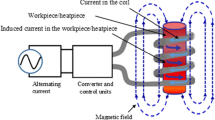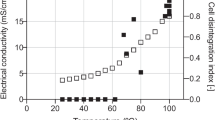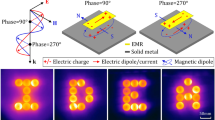Abstract
Radio frequency energy is utilised for heating in a wide range of applications, particularly in the food industry. A major challenge of RF processing is non-uniform heating in loads of variable and angular geometry, leading to reduced quality and product damage. In this study, the specific effects of geometry on the heating profiles of a range of geometrically variable loads in an industrial scale RF system are analysed, and the understanding used to derive a general tool to predict heating uniformity. Potato was selected as a test material for experimental work; dielectric properties were measured using a 44-mm coaxial probe. Analysis of simulated and experimental surface temperature profiles and simulated power uniformity indices indicates the presence of vertices and edges on angular particles, and their proximity to faces perpendicular to the RF electrodes increases localised heating; faces parallel to the electrodes heated less than those faces perpendicular to them. Comparison of the same geometrical shape in different orientations indicates that overall power absorption uniformity can be better even when localised heating of edges is greater. It is suggested, for the first time, that the rotation of angular shapes within a parallel plate electric field can improve heating uniformity, and that this can be achieved through the design of bespoke electrode systems. A Euler characteristic-based shape factor is proposed, again for the first time, that can predict heating uniformity for solid, dielectrically homogeneous shapes. This gives industry a tool to quickly determine the feasibility for uniform RF heating of different three-dimensional shapes based on geometry alone. This provides a screening method for food technologists developing new products, allowing rapid assessment of potential heating uniformity, and reducing the need for early-stage specialist computational modelling.






Similar content being viewed by others
References
ASHRAE (2006). ASHRAE handbook—refrigeration (I-P edition). American Society of Heating, Refrigerating and Air-Conditioning Engineers, Inc.
ASTM, (2014). Standard test method for determining moisture in raw and spent materials.
Awuah, G. B., Ramaswamy, H. S., & Tang, J. (2014). Radio-frequency heating in food processing: principles and applications. CRC Press.
Birla, S. L., Wang, S., Tang, J., & Hallman, G. (2004). Improving heating uniformity of fresh fruit in radio frequency treatments for pest control. Postharvest Biology and Technology, 33(2), 205–217.
Clarke, B., (2003). A guide to the characterisation of dielectric materials at RF and microwave frequencies. Institute of Measurement and Control.
COMSOL Multiphysics, (2012). 4.3 user’s guide. COMSOL.
Hou, L., Johnson, J. A., & Wang, S. (2016). Radio frequency heating for postharvest control of pests in agricultural products: a review. Postharvest Biology and Technology, 113, 106–118.
Jiao, Y., Tang, J., & Wang, S. (2014). A new strategy to improve heating uniformity of low moisture foods in radio frequency treatment for pathogen control. Journal of Food Engineering, 141(0), 128–138.
Katrib, J., Folorunso, O., Dodds, C., Dimitrakis, G., & Kingman, S. W. (2015). Improving the design of industrial microwave processing systems through prediction of the dielectric properties of complex multi-layered materials. Journal of Materials Science, 50(23), 7591–7599.
Laycock, L., Piyasena, P., & Mittal, G. S. (2003). Radio frequency cooking of ground, comminuted and muscle meat products. Meat Science, 65(3), 959–965.
Liu, Y., Tang, J., Mao, Z., Mah, J.-H., Jiao, S., & Wang, S. (2011). Quality and mold control of enriched white bread by combined radio frequency and hot air treatment. Journal of Food Engineering, 104(4), 492–498.
Liave, Y., Terada, Y., Fukuoka, M., & Sakai, N. (2014). Dielectric properties of frozen tuna and analysis of defrosting using a radio-frequency system at low frequencies. Journal of Food Engineering, 139(0), 1–9.
Metaxas, A. A., Meredith, R.J., (1983). Industrial microwave heating.
National Physical Laboratory, (2015). Coaxial Sensors for SAR.
Orsat, V., Gariépy, Y., Raghavan, G. S. V., & Lyew, D. (2001). Radio-frequency treatment for ready-to-eat fresh carrots. Food Research International, 34(6), 527–536.
Radiometric Infrared Solutions, (2011). Radiometric Complete 5.1 Manual
Romano, V., & Marra, F. (2008). A numerical analysis of radio frequency heating of regular shaped foodstuff. Journal of Food Engineering, 84(3), 449–457.
Saunders, P., (2004). Non-contact temperature measurement in the food industry. Measurement Standards Laboratory of New Zealand.
Sosa-Morales, M. E., Valerio-Junco, L., López-Malo, A., & García, H. S. (2010). Dielectric properties of foods: reported data in the 21st century and their potential applications. LWT - Food Science and Technology, 43(8), 1169–1179.
Tiwari, G., Wang, S., Tang, J., & Birla, S. L. (2011). Analysis of radio frequency (RF) power distribution in dry food materials. Journal of Food Engineering, 104(4), 548–556.
Engineering Toolbox (2015). http://www.engineeringtoolbox.com/
Uyar, R., Bedane, T. F., Erdogdu, F., Koray Palazoglu, T., Farag, K. W., & Marra, F. (2015). Radio-frequency thawing of food products—a computational study. Journal of Food Engineering, 146(0), 163–171.
Uyar, R., Erdogdu, F., Sarghini, F., & Marra, F. (2016). Computer simulation of radio-frequency heating applied to block-shaped foods: analysis on the role of geometrical parameters. Food and Bioproducts Processing, 98, 310–319.
Wang, J., Luechapattanaporn, K., Wang, Y., & Tang, J. (2012). Radio-frequency heating of heterogeneous food—meat lasagna. Journal of Food Engineering, 108(1), 183–193.
Wang, S., Yue, J., Tang, J., & Chen, B. (2005). Mathematical modelling of heating uniformity for in-shell walnuts subjected to radio frequency treatments with intermittent stirrings. Postharvest Biology and Technology, 35(1), 97–107.
Acknowledgments
The authors would like to thank the National Physical Laboratory for the loan of their low-frequency coaxial probe for dielectric measurements at radio frequencies.
Author information
Authors and Affiliations
Corresponding author
Additional information
R. S. Ferrari-John and J. Katrib are equal contributors.
Rights and permissions
About this article
Cite this article
Ferrari-John, R.S., Katrib, J., Palade, P. et al. A Tool for Predicting Heating Uniformity in Industrial Radio Frequency Processing. Food Bioprocess Technol 9, 1865–1873 (2016). https://doi.org/10.1007/s11947-016-1762-6
Received:
Accepted:
Published:
Issue Date:
DOI: https://doi.org/10.1007/s11947-016-1762-6




